Written by Mark Schackmuth
As the 2019 Chicago White Sox season draws to a close, and the attention of a majority of weary Sox fans begins to shift towards the glorious fall spectacle that is college and professional football, a select few gluttonous masochists are just getting lathered up. For 2020, whether Rick Hahn and co. are willing to admit it or not, will be a transformational year for Chicago White Sox baseball. While it is tempting to get dragged down by the win-loss record, the head-scratcher lineups, or the roughly two-thousand plate appearances taken by role players masquerading as regular contributors, none of these things will ultimately shape the trajectory of the franchise at 35th and Shields much moving forward. On the contrary, there have been a number of significant developments which have adjusted that trajectory firmly upward, and regardless of how many poor excuses Rick Hahn has to conjure up to explain away the club’s preference for team control over a cup of coffee for the organization’s star prospects, enduring the last three seasons of amateur performances will begin to pay off for White Sox employees and fans alike beginning next April.
The Young Core has Emerged
The positives of the 2019 season are well-known, so there is no need to elaborate much here. Lucas Giolito has transformed from perhaps the league’s worst starting pitcher to a top-10 starting pitcher by fWAR. Yoán Moncada has overcome a potential fatal-flaw to scratch his superstar potential in his age-24 season. TIM ANDERSON IS COMPETING FOR THE AMERICAN LEAGUE BATTING TITLE. James McCann was signed off the scrap heap and has emerged as a solid starting catcher and an organizational leader. Eloy Jiménez has exhibited stretches of future baseball destruction to come. Reynaldo Lopez has been durable, shown flashes of dominance, and appears to have cemented a role in the starting rotation.
To be fair, none of these occurrences in isolation signals competitive baseball on the horizon on the Southside. And there is certainly an argument for regression with Tim Anderson and James McCann. However, the confluence of them together is an extremely significant development. All consistently competitive teams require a young, affordable core from which to build. When Rick Hahn traded Chris Sale, José Quintana and Adam Eaton, his primarily goal was to bring back that young core. While the jury is still out on Dylan Cease, Michael Kopech and Dane Dunning, it appears that the White Sox have certainly achieved the goal of acquiring the necessary cornerstones from which to fortify sustainable competitiveness beginning as early as next season.
The Cavalry is Coming
Two of the larger developments relative to 2019 White Sox have yet to make an appearance for the big league club, but they may just result in having some of the largest impacts on the 2020 White Sox. Of course, I’m referring to Luis Robert and Nick Madrigal. Although neither were given the opportunity to exhibit their wares in Chicago this season, and may even begin the 2020 season in Charlotte, both players should be regular big league starters before the middle of April arrives. Yes, it is frustrating. No, it is not fair to either of these young men. It is also sound business practice, and will provide the White Sox with team control of both players through the 2026 season.
It is nearly impossible to overstate the importance of the development of these two Sox farmhands, particularly Robert. Coming into the season, Robert was still respected in top-100 prospect lists, but significant questions regarding his hit tool, as well as his ability to remain healthy, had arisen as a result of his 2018 campaign. To state that the team’s top prospect has silenced these concerns is an understatement. After a season in which he destroyed three separate levels of professional baseball, and put together a 30 home run, 30 stolen base campaign, all while hitting .328/.376/.624, Robert has deservedly taken home MLB Pipeline’s Minor League Hitter of the Year Award. He is now considered to be one of the top prospects in all of Major League Baseball.
Madrigal’s year was also incredibly impressive – although not as obnoxiously gaudy as Robert’s – hitting .311/.377/.414 across the same three levels, while only striking out SIXTEEN times all season. An outstanding fielder who clearly possesses the “it” factor, Madrigal is a lock to hold down second base for the majority of the 2020’s for the White Sox. I don’t think anyone would be surprised if Madrigal won multiple American League batting titles before his tenure in Chicago is complete.
A Strong Foundation for the Future
By the middle of April next year, Rick Renteria will be filling out a lineup card featuring young, affordable and effective ballplayers at catcher, third base, shortstop, second base, left field and center field. He will also feature a starting rotation of at least four arms between the ages of twenty three and twenty six. Barring extensions, the combined annual 2020 salary of all ten of these players will likely be below $20 million. The cumulative Wins Above Replacement (“WAR”) for these same ten players reasonably projects to be between 26 and 35, meaning the White Sox will be paying roughly $575,000 and $770,000 per WAR for this subset of foundational players. This is between six and nine percent of the average cost of one WAR, at approximately $9 million. Or put another way, the White Sox will likely be receiving between thirteen and seventeen times the average value of a WAR from their core subset of players. This is an indisputably strong position from which to build future sustained competitiveness.
Remaining Positional Role Players
However bright the future may be, we must not discard all semblance of the present. José Abreu will undoubtedly return as part of a late-season or off-season extension. While Abreu is not a perfect player, he is nothing if not dependable, both on the field and off. One of the most consistent run-producers over the course of his White Sox tenure, Pito is also a stabilizing force within the White Sox clubhouse. Although it is unlikely that Abreu will post anymore three, four or five WAR campaigns, at age thirty-two, he likely has a few more 30 HR/100 RBI seasons in his bat, and his comforting presence on the young Latin-American contingent of the White Sox provides additional value. Bringing José back on a two-year, $25 million extension isn’t likely a deal either party would be harmed by.
Leury Garcia also appears to have established enough value to warrant a return in 2020. His positional versatility is undervalued, and despite his aggressive approach as well as an inability throughout his White Sox tenure to remain particularly healthy, at an anticipated arbitration cost of around $3 million, bringing little “Leroy” back isn’t a decision Rick Hahn will waste much time pondering.
Yolmer Sánchez – once appearing to be a lock to be designated for assignment after the 2019 season—is quietly making a late push to convince White Sox brass to return. Perhaps known more for his Gatorade antics than his on-field exploits, Sánchez has been more consistent than Leury Garcia in recent years and makes a reasonable case to be brought back as another versatile role-player. What will likely hold Yolmer back is his price tag, as it is possible he may ask for $6+ million in arbitration. Despite plenty of payroll flexibility, I would anticipate the White Sox to choose Garcia over Sánchez in this debate due to his ability to play both infield and outfield positions, with the outside possibility of Yolmer re-signing with the Club at a lower price tag.
The Bullpen
To put things bluntly, 2019 has not been the year of the bullpen for the White Sox. Despite Rick Renteria’s strong bullpen management – which is all the more impressive given the lack of depth he’s had to work with – this is likely the area where the White Sox’ pro scouting will be tested the most. Locks to return in 2020 will be Alex Colomé, Kelvin Herrera, Aaron Bummer, Jimmy Cordero and likely Evan Marshall. While the White Sox’ system features an extension collection of potential pen arms moving forward, Bummer and the recently improved Cordero represent perhaps the best two pieces moving forward.
State of the Rebuild
It is difficult to evaluate the White Sox rebuild in isolation. There are many intelligent minds who disagree as to whether the effort resembles recent successful rebuilds that have taken place in other organizations, or if things resemble earlier White Sox rosters dubbed by some as “stars and scrubs.” Thus, a little context and comparison is in order. The most recent examples of successful rebuilds, in part because they resulted in teams going from worst to first, and ultimately, World Series Championships, but also because they were clearly labeled as such by their respective front offices, are the Houston Astros and the Chicago Cubs.
The Houston Astros’ Rebuild
The Astros began in earnest after the 2011 season when Jeff Luhnow was hired, and lasted through the 2014 season. Between the 2012 and 2014 seasons, the Astros lost 310 games, and that is not counting the 106 games they lost in 2011 before General Manager Ed Wade was fired. In 2015, Houston broke through with an 86-win season, and a second place finish in the American League West. Their Pythagorean win-loss record indicated they should have been even better, at 93-69. The 2014 Astros roster featured three players who tallied more than two bWAR (baseball-reference’s version of Wins Above Replacement), albeit well above that in Jose Altuve (6.1 bWAR), Dallas Keuchel (4.8 bWAR) and Collin McHugh (4.0 bWAR). In sum, they had twelve players at 1.0 bWAR or higher. See the bWAR values for the 2014 Houston Astros below, from baseball-reference.com:
Figure 1 – 2014 Houston Astros players above 1.0 bWAR

In 2015, we see the Astros had fifteen players at 1.0 bWAR or higher, including five players above 2.0 bWAR. Dallas Keuchel and José Altuve continued to lead the way, and a young Carlos Correa burst onto the scene, producing 4.3 bWAR. The Astros also saw key contributions from newcomers Colby Rasmus, Luis Valbuena and Will Harris.
Figure 2 – 2015 Houston Astros players above 1.0 bWAR
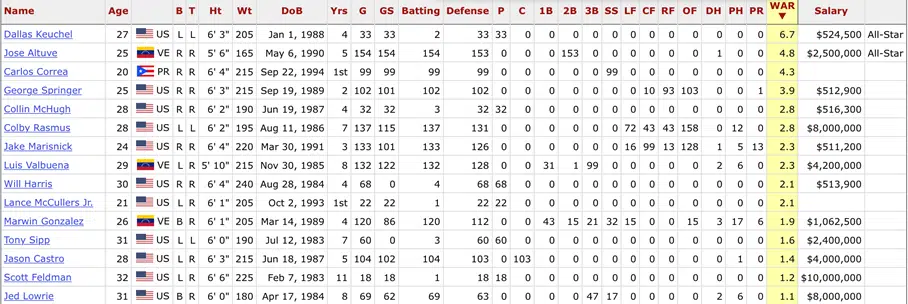
It appears that a key difference between the Astros’ 92-loss season in 2014 and their 86-win season in 2015 was the increase in both one and two bWAR players. Additionally, the continued excellence of Altuve and Keuchel, as well as the emergence of Correa in 2015 were critical in making the transition from a bottom-dweller to contender.
Of course, executing on a successful rebuild is more than just adding impact players to your roster year over year; success is also a function of eliminating below average players. If we compare the players on the Astros roster between 2014 and 2015 that produced a negative bWAR, we see a significant dropoff in that regard.
Figure 3 – 2014 Houston Astros players below 0 bWAR
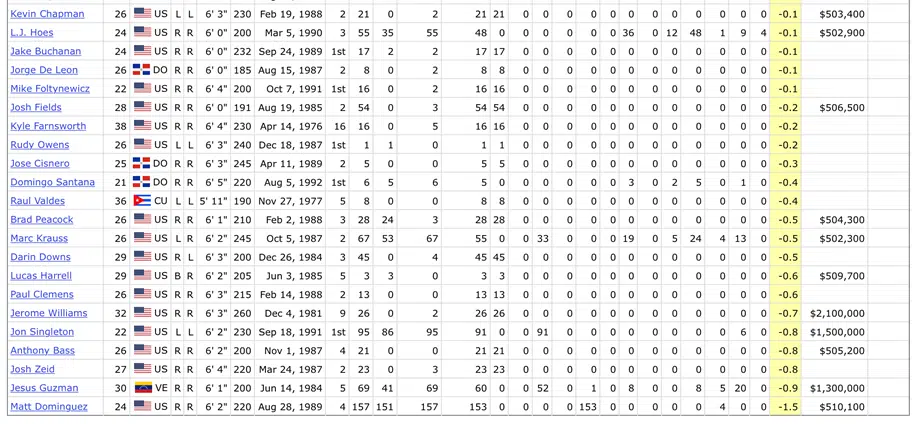
As we can see above, the 2014 Astros featured twenty-two players that posted a cumulative negative bWAR of 10.4. To make matters worse, the Astros paid $9 million for this poor production. One key to reversing their losing ways in 2015 was to eliminate many of these players from their roster, and replace them with those who would produce at an above replacement level pace.
Figure 4 – 2015 Houston Astros players below 0 bWAR

As we can see above, in 2015, the Astros did exactly that, improving from twenty-two negative bWAR players to just ten and a cumulative 2.7 negative bWAR. Even though they paid even more for that poor production in 2015, the mere impact of putting forward a roster with less dead weight was enough to overcome the poor allocation of funds.
While it would take a few more years to break through, the steady foundation built by the Astros sustained them while Jeff Luhnow rounded out his roster through additional development, as well as free agent signings and trade acquisitions.
The Chicago Cubs’ Rebuild
The Chicago Cubs’ rebuild took a similar path as the Astros. Much like the Astros hired Jeff Luhnow in 2011, the Cubs hired Theo Epstein to mastermind their rebuild in October of that same year. Epstein immediately went about the process of selling off and stripping down payroll from the Major League roster. Through a combination of strong international signings, selecting at the high end of the draft, trade acquisitions, and finally, free agent signings, Epstein transformed a disaster of a roster to one that was admired throughout Major League Baseball. However, much like with the Astros, this metamorphosis did not occur overnight. Between 2012 and 2014, the Cubs lost a total of 286 games, and they also lost 87 and 91 games in the two seasons prior to Epstein’s arrival.
In 2014, the Cubs roster featured six players above two bWAR, and fourteen above one bWAR, including four players above three bWAR. Given this strong production at the top of their roster, it is surprising that the Cubs only won 73 games that year, however, it is important to remember that Epstein traded two of his better arms away early in July, moving Jeff Samardzija and Jason Hammel to the A’s for top prospect Addison Russell. As a result, the Cubs played the final three months of the season without two of their top bWAR producers.
Figure 5 – 2014 Chicago Cubs players above 1.0 bWAR

Much like the Astros, it was in 2015 that the Cubs broke through. The additions of Kris Bryant and Russell, as well as high-profile starting pitcher Jon Lester through free agency proved to be a big shot in the arm to the continued high-level production of Jake Arrieta and Anthony Rizzo. The 2015 Cubs featured three players above six bWAR, seven above two bWAR, and fifteen at or above one bWAR. Once again, like the Astros and Correa, the addition of a superstar level performer in Bryant as well as other supplemental production led to a huge increase in wins from the previous season.
Figure 6 – 2015 Chicago Cubs players above 1.0 bWAR

Of course, the 2014 Cubs also had their fair share of negative bWAR players. As we see below, they rostered twenty players below replacement level, with a cumulative negative bWAR of 12.8.
Figure 7 – 2014 Chicago Cubs players below 0 bWAR
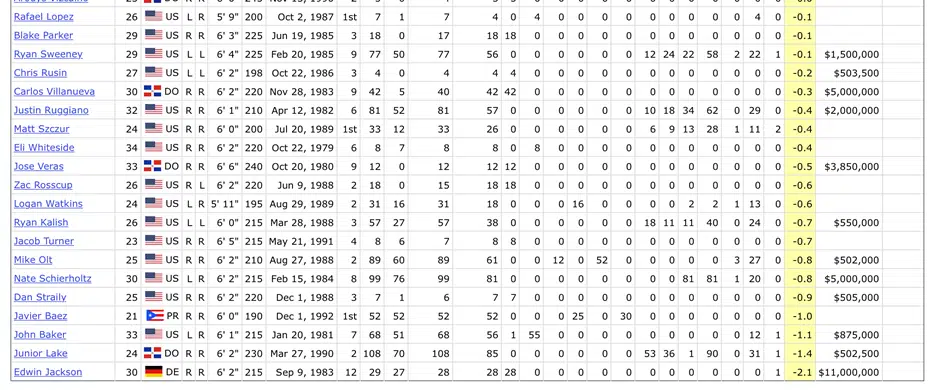
However, in 2015, as we see below, that number shrunk to seventeen players, but more importantly, the cumulative negative bWAR was reduced from 12.8 to just 5.1 negative bWAR.
Figure 8 – 2015 Chicago Cubs players below 0 bWAR
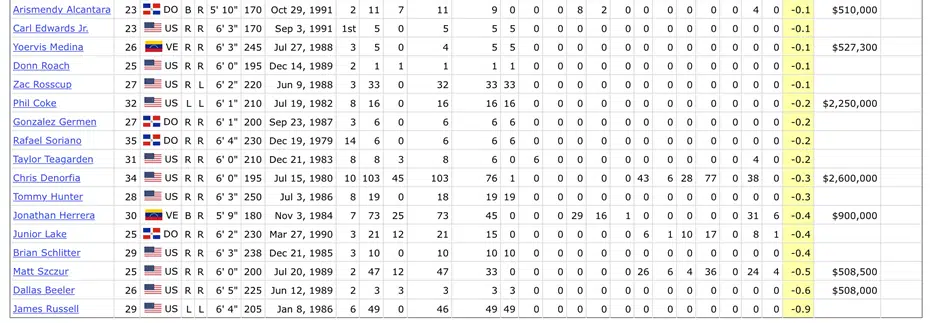
The 2019 Chicago White Sox
So how do the 2019 White Sox compare to the rebuilds of the Astros and Cubs? Are the White Sox ready to make a similar leap? With twenty-one games remaining, the 2019 White Sox feature six players above two bWAR and twelve at or above one bWAR. It is reasonable to assume that should they stay healthy, Tim Anderson, James McCann and Yoán Moncada will all exceed 3.5 bWAR. As we can see with our Astros and Cubs examples, a jump from seventy-ish wins to ninety-ish wins seems to result from not only having the capacity to maintain a roster flush with productive, young and affordable players, but also to inject all-star or superstar-level players into the mix while reducing the number of dead weight players producing negative wins. As a result of the additions of Luis Robert and Nick Madrigal, as well as significant payroll flexibility, the White Sox are in a very strong position to add this caliber of talent to their 2020 roster.
Figure 9 – 2019 Chicago White Sox players above 1.0 bWAR

What about negative bWAR from the 2019 White Sox roster? As we see below, the White Sox have featured an abundance of players producing negative bWAR. There will likely be between twenty and twenty three players fulfilling this unfortunate classification, and as it stands today, they have produced a cumulative 12.5 negative bWAR, If the Astros and Cubs are any indication, and perhaps even more importantly for the White Sox than the issue of bringing in positive impact players, is to eliminate as much dead weight and negative bWAR as possible in the 2020 season.
Figure 10 – 2019 Chicago White Sox players below 0 bWAR
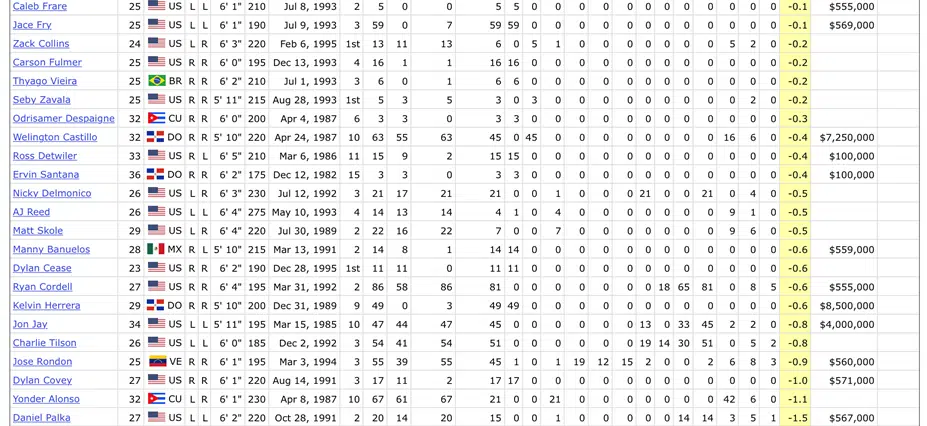
2020 and Beyond
As stated above, the Chicago White Sox are in a very strong position to make the transition from rebuilding to competing in 2020. Not only does their roster contain a number of pieces that will continue to develop into better producing assets, the fact that a significant portion of their core will be in place, along with outstanding payroll flexibility and a reasonably strong farm system will provide Rick Hahn and co. with the ability to be very opportunistic moving forward. According to Spotrac.com, the White Sox will have less than $24 million in payroll commitments. While arbitration signings will likely double this figure, that still provides something like $60-75 million in 2020 annual salary to add assuming a 2020 payroll between $110 and 125 million. How Rick Hahn determines that money will be spent will weigh heavily on the trajectory of the White Sox moving forward.
Potential Free Agent Acquisitions
Looking at the potential 2020 White Sox roster, the biggest holes appear to be at first base, right field, designated hitter/catcher, starting pitcher, and two or three bullpen vacancies. While $60-75 million seems like a significant amount of money, it doesn’t go as far as it once did. This article wouldn’t be much fun if we didn’t spend a little (ok, a lot) of Jerry Reinsdorf’s money in trying to build out this 2020 roster. Below represents my attempt to do so:
- José Abreu – 1B/DH – 2 Years/$25 million/$12.5/$12.5
- Cole Hamels – SP – 2 Years/$35 million/$17.5/$17.5
- Yasmani Grandal – C/DH – 3 Years/$50 million/$17/$17/$16
- Yasiel Puig – RF – 3 Years/$42 million/$14/$14/$14
- Dellin Betances – RP – 2 Years/$16 million/$8/$8
- Will Harris – RP – 2 Years/$10 million/$5/$5
While none of these additions carry the panache of a Gerrit Cole or Anthony Rendon acquisition, they are reasonable signings that fill gaps and carry relatively little risk. If one or two simply don’t work as planned, they will not punish the Organization for years to come. All are short-term in nature, and provide a bridge to the 2022-2025 window when many of the core pieces will be in the midst of their primes. The table below depicts forecasted bWAR (my own) of some of the top 2020 White Sox performers:
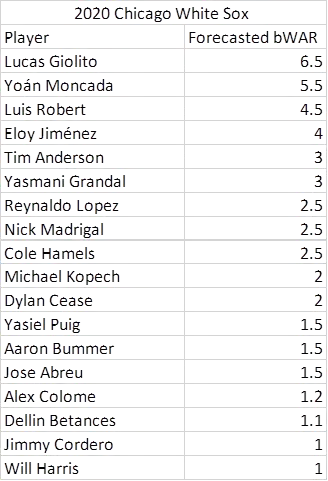
As we can see, such an outcome would result in eleven players above two bWAR, and eighteen at or above one bWAR. Six players are at 3 bWAR or better. While this is undoubtedly optimistic, as there will be injuries and underperformance, I don’t find it to be unreasonable. It is merely a reflection of the potential that features a roster with so many young cornerstones, and the resulting significant free agent expenditures. While many skeptics will scoff at the notion of Jerry Reinsdorf spending this way in free agency, it is important to note that the total expenditure for the six players listed above is $178 million, or some $72 million less than what was offered to Manny Machado this past offseason. I don’t believe it is outside of the realm of possibilities to suggest this front office would make this type of effort to compete over the next two-to-three seasons.
Potential Trades
Of course, it is very likely that free agency won’t unfold as I prophesize above, and a principle reason may be as a result of the trade market, particularly relative to the opening in right field. We could see the White Sox and Dodgers revisit the Joc Pederson transaction, or perhaps even AJ Pollock, as the Dodgers have plenty of options in their outfield. Another possibility could be the Angels’ Kole Calhoun, as the Angels have a certain prospect named Jo Adell primed to break on the scene. Perhaps Michael Brantley even becomes available, with the addition of Kyle Tucker (finally) in the Astros outfield.
Conclusion
Ultimately, there are a number of paths the White Sox front office can take as a result of the way this rebuild has unfolded. That is precisely the beauty of a well-executed rebuild – the payroll flexibility created from a talented young core – allows for a multitude of options, leaving Rick Hahn with the ability to be opportunistic rather than desperate.
To be clear, signing the likes of Gerrit Cole would fill a need, and yet, I tend to think that need will be much less significant in one-to-two years’ time. While it is true that one can never have enough starting pitching, what far more often occurs is that a team spends far too much on starting pitching. Considering the stuff the White Sox rotation possesses, the need for top-of-the-rotation stuff will likely not produce the benefit that an expenditure like Cole would require. I’d prefer Rick Hahn make smaller gambles based on a belief that one day Lucas Giolito, Michael Kopech and Dylan Cease provide all the top-of-the-rotation quality pitching this club needs. And if they don’t? Take a lesson from Jeff Luhnow and acquire the veteran ace by way of a much smaller commitment on the trade market.
The more likely path to success is to build upon the continual additions to the White Sox core through a series of opportunistic free agent signings and trades. Contrasting the Astros current state versus the Cubs, we see a clear difference resulting from the cool and calculated opportunism exhibited by Luhnow and the Astros, versus Epstein and the Cubs more aggressive approach. As a result, the Cubs are exhausting all of their available payroll resources and prospect capital, while the Astros are operating on all cylinders, like a well-oiled machine. The latter is certainly not the approach the fans appreciate until it is proven, but I believe it is the approach Hahn and Co. will take.
Addressing the criticism of some, particularly regarding depth, and the potential of this roster to resemble previous “stars and scrubs” rosters from earlier in the decade, I simply don’t buy that. As we saw in Figure 10 above, while there is significant negative bWAR being produced by the 2019 roster, I am hard-pressed to see more than four or five of those players making the 2020 roster (Collins, Cease, Herrera, Fry, Frare?). This is because a) there exists far more organizational depth than was the case in previous years, and b) significant payroll flexibility will allow the White Sox to replace these players with free agent signings, most of which will have strong track records of success. As a result, we should see a strong reduction in players producing negative bWAR in 2020, but more importantly, the cumulative negative bWAR produced by the 2020 roster. This will lead to fewer “scrubs,” as the White Sox will begin to deploy their capital, and significantly more wins as the overall character of the roster is drastically improved.
Moreover, as much as the White Sox teams of 2012-2015 contained stars in Chris Sale, José Abreu, José Quintana and Adam Eaton, there was far more upward pressure on payroll with little help coming from a beleaguered farm system. Contrasting that core with one composed of Giolito, Moncada, Robert, Anderson, Jiménez, Kopech, Cease and Madrigal, and well, they are not particularly comparable. This will not be another stars and scrubs roster, but instead, a roster featuring superstars, all-stars, above-average starters, solid role players, and far less dead weight near the bottom of the roster.
Whether the next Division Championship comes in 2020, or 2022, I feel comfortable in saying it is indeed coming soon. And once it gets here, there is a strong potential that it will be here to stay.
Follow Mark Schackmuth on Twitter @iamshack24
Featured Photo: Chris Tejeda/@FotoGenocide_

I throughly enjoyed your article and agree with your potential free agents signings. The Sox just aren’t going to sign any Scott Boras clients so it’s smart to look at the other talented players.
Outstanding Article.
This was well written and well stated, however, I changed your projected FA signings.
1. Jose Abreu – 1B/DH 3 years – $45M/$15/$15/$15
2. Gerrit Cole – SP – 7 years – $224M/$32/$32/$32/$32/$32/$32/$32
3. Yasmani Grandal – C/DH – 3 years – $48M/$16/$16/$16
4. Dellin Betances – RP – 2 years – $16M/$8/$8
5. Will Smith – RP – 2 years – $10M/$5/$5
6. Adam Jones – RF – 1 year – $4M
$80M added to payroll
If Jerry really wants a winner he wont go cheap in RF, but for the exercise I kept it as close to the max of $75M. Abreu will likely command more than $12.5M. I don’t like Puig, I’d rather have Castellanos on a 4 year $64M deal. If we don’t get Cole the offseason is a failure. Strasburg would be a great consolation prize, Cole Hamels would be a disappointment. I loved your article and have high hopes for 2020 just like you.